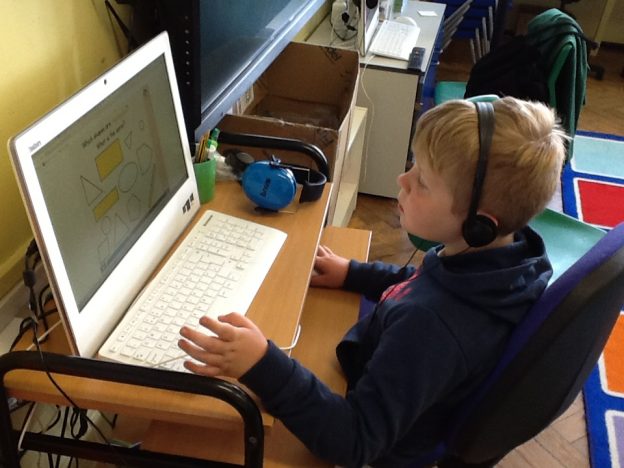Address:
William Patten Primary School
Stoke Newington Church Street
London N16 0NX
Office Manager: Rita Quigley
SENDCo: Caitlin Shaw
William Patten Primary School
Stoke Newington Church Street
London N16 0NX
Office Manager: Rita Quigley
SENDCo: Caitlin Shaw

Intent
Our aim is to give children a thorough and ambitious education in computing, equipping them to use technology, computational thinking and creativity to understand and change the world. It is now more important than ever that children are able to use technology positively, responsibly and safely, and that they see good models of this.
By the time they leave William Patten, children will have gained key knowledge and skills in the three main strands of the National Curriculum for Computing (2014): computer science (programming and understanding how digital systems work), information technology (using computer systems to create, store, retrieve and send information) and digital literacy (evaluating digital content and using technology safely and respectfully). Furthermore, from Nursery to Year 6, experiences in computing and the wider curriculum are planned to develop children’s computational thinking skills.
Our knowledge-engaged curriculum enables children to understand how computers and computer systems (such as the internet) work, and how they are designed and programmed. It ensures they know what to do if they have concerns about anything they encounter online, and how to be safe, responsible and respectful when using the internet. Equally, our offer provides many opportunities for learners to apply their evolving knowledge imaginatively, becoming fluent and creative in their mastery of computing. The depth and breadth of our coverage aims to provide all our children with a solid grounding for future learning and the ability to become active digital citizens in the modern world.
Implementation
At William Patten, computing is taught using a blocked-curriculum approach, in which lessons are taught consecutively during a two-week block, rather than once per week over each term. Teachers use specified units from the updated ‘Switched On: Computing’ scheme, published by Rising Stars, as a starting point for the planning of their computing lessons. The key knowledge and skills that must be taught within each unit have been identified and carefully mapped to support the progression of children’s learning across the primary phases, building towards mastery of the end of key stage objectives from the National Curriculum. Freedom for teachers to develop and adapt computing units within the framework of the progression map leads to rich links with engaging contexts in other subjects and topics, while still ensuring systematic coverage of objectives. An overview of each unit’s key vocabulary, key knowledge and linked prior knowledge is shared with families and children before each computing block begins, through our ‘Topic Vocabulary’ mats. After completing a unit, learners complete a brief key knowledge quiz to assess and reinforce their retention and understanding of core facts and concepts. They then write a summary of what they know according to the key knowledge statements identified on the progression map (as worded on the TV Mat of the topic). Teachers support the children and scaffold this ‘knowledge summary’ as appropriate, according to the children’s age group, as well as individual needs. This process is used to further consolidate the key knowledge of the topic and each strand of knowledge included in the outcomes is ticked or highlighted.
Our computing progression framework ensures a balanced coverage of the three computing strands (computer science, information technology and digital literacy). The children work on all three strands each year. As they progress through the school, children build on their prior learning within each strand, covering new or deeper knowledge and developing their technical skills. Within all sequences of lessons, teachers plan a phase of progressive questioning which extends to and promotes the higher order thinking of all learners. Questions initially focus on the recall or retrieval of knowledge, and help to scaffold computational thinking skills, such as pattern recognition. Questions then extend to promote application of the knowledge in a new situation and are designed to promote independence in analytical thinking.
The relevant, context-embedded computing experiences through which our knowledge-engaged curriculum is taught will benefit learners in secondary school, further education and future workplaces. From research methods, use of presentation and creative tools and computational and critical thinking, computing at William Patten gives children the building blocks that enable them to pursue a wide range of interests and vocations in the next stage of their lives.
Impact
Our approach to the curriculum provides fun, engaging and meaningful learning for all pupils, in which the children understand not only the content that is taught but the opportunities offered to them by their computing education, enabling them to become creators and change-makers in our digital world. The impact of our curriculum and the quality of children’s learning is evident in their work, which is shared, published and celebrated on Seesaw (an online platform) and in their topic books – using photographs and QR codes to showcase digital work. Fortnightly monitoring of these outcomes, alongside key knowledge quiz results, and interviews with teachers and learners, allows the subject lead to ensure the knowledge-engaged curriculum taught is being learned and retained by all pupils. All this information also feeds into teachers’ future planning and enables assessment of pupil’s knowledge and skills. Through cross-curricular uses of computing in other subjects, teachers are able to revisit misconceptions and knowledge gaps in computing in tandem with other curriculum areas. This supports varied paces of learning and ensures all pupils make good progress.